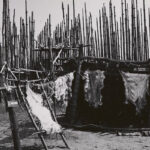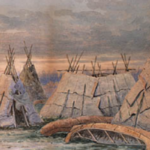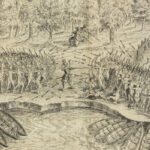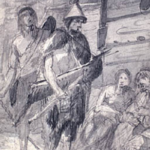The Bigstone Cree Nation: Guardians of the Boreal Forest and Its Resources
The Bigstone Cree Nation, part of the larger Plains and Woodland Cree peoples, has lived in the boreal forests and waterways of northern Alberta for thousands of years. Centered around the Wabasca area, the Bigstone Cree have built a vibrant culture deeply tied to the land and its resources. Known for their resilience and stewardship of their ancestral territories, the Bigstone Cree Nation has maintained its cultural identity despite the challenges posed by European colonization and industrial development. Their story is one of continuity, adaptation, and commitment to cultural preservation.
Ancient Origins: People of the Boreal Forest
The Bigstone Cree Nation’s origins are rooted in the Nêhiyawêwin-speaking Cree peoples, who have inhabited the boreal forests of northern Alberta for over 10,000 years. The region’s abundant natural resources, including fish, game, and plant materials, provided sustenance and shaped their seasonal cycles of movement. The area around Wabasca, with its interconnected lakes and rivers, served as an important hub for hunting, fishing, and gathering.
The Bigstone Cree’s connection to the land is reflected in their name, with “Bigstone” symbolizing their presence in the rocky and forested terrain. Their language, traditions, and stories are deeply tied to this landscape, emphasizing respect for the environment and sustainable resource management.
Anthropologist Marianne Ignace, in Keeping the Stories Alive, writes, “For the Bigstone Cree, the boreal forest was more than a place to live—it was the foundation of their cultural identity and spiritual worldview.”
Governance and Social Structure
Traditional governance among the Bigstone Cree followed principles of consensus and collective decision-making. Leaders were chosen for their wisdom, hunting skills, and ability to maintain harmony within the community. Elders played a key role in guiding decisions, sharing knowledge, and ensuring the preservation of cultural traditions.
The Bigstone Cree organized themselves into family groups that moved seasonally to follow game and fish. Ceremonial gatherings were opportunities to strengthen social bonds, share stories, and honor the Creator. These practices ensured cohesion within the community and reinforced their cultural identity.
Historian Robin Fisher, in Contact and Conflict, observes, “The governance of the Cree nations, including the Bigstone Cree, was deeply embedded in their cultural practices, ensuring harmony within their communities and with the land.”
Spiritual and Cultural Traditions
The Bigstone Cree’s spiritual worldview is deeply tied to the natural world. Ceremonies such as the sweat lodge, pipe ceremonies, and seasonal feasts reflect their connection to the Creator and the cycles of nature. These rituals emphasize renewal, healing, and gratitude for the land’s resources.
Storytelling is central to Bigstone Cree culture, preserving knowledge about hunting, navigation, and environmental stewardship. Stories about Wisakecahk, the trickster figure, conveyed moral lessons and practical wisdom, reinforcing the values of respect, resilience, and balance.
Trade and Regional Influence
The Bigstone Cree were active participants in the fur trade networks that emerged in the boreal forest. Their strategic location near waterways allowed them to act as intermediaries between European traders and inland communities. They exchanged furs, meat, and fish for goods such as metal tools, firearms, and textiles, integrating these items into their daily lives.
Historian Jean Barman, in West Beyond the West, writes, “The Bigstone Cree’s adaptability and knowledge of the land positioned them as vital players in the dynamic networks of trade and cultural exchange in the northern frontier.”
First Contact with Europeans
The Bigstone Cree’s first recorded contact with Europeans occurred in the late 18th and early 19th centuries, during the expansion of the Hudson’s Bay Company and North West Company into northern Alberta. These interactions introduced new goods and opportunities but also brought devastating consequences, particularly in the form of disease.
Epidemics of smallpox, measles, and influenza swept through Bigstone Cree communities, drastically reducing their population. Anthropologist Bruce Trigger, in Indigenous Peoples of Canada, describes these epidemics as “a demographic catastrophe that reshaped the cultural and social dynamics of Indigenous nations.”
Treaties and Colonization
The signing of Treaty 8 in 1899 marked a turning point for the Bigstone Cree Nation. This treaty promised to protect their traditional livelihoods, including hunting, fishing, and trapping, while allowing for settler expansion and industrial development. However, like many treaties, its implementation often failed to meet the promised commitments, leading to land dispossession and economic challenges.
The establishment of reserves under the Indian Act confined the Bigstone Cree to limited portions of their traditional territories. Residential schools further disrupted their communities, as children were forcibly removed from their families and prohibited from speaking their language or practicing their traditions.
Historian Margaret Conrad, in A Concise History of Canada, writes, “The promises of Treaty 8, like those of other numbered treaties, were often overshadowed by systemic marginalization and the erosion of Indigenous rights.”
Resilience and Cultural Revitalization
Despite the challenges of colonization, the Bigstone Cree Nation has demonstrated remarkable resilience. Efforts to preserve their language, Nêhiyawêwin, and restore traditional ceremonies have been central to their cultural revitalization. Programs in cultural education and youth mentorship ensure that future generations remain connected to their heritage.
The Bigstone Cree have also been leaders in advocating for Indigenous sovereignty and self-determination. Legal settlements and negotiations have resulted in the expansion of their land base and recognition of their rights under Treaty 8.
Anthropologist Marianne Ignace notes, “The Bigstone Cree Nation’s dedication to revitalizing their culture and asserting their rights is a testament to their resilience and determination.”
Environmental Stewardship
The Bigstone Cree Nation has long been a steward of the boreal forest and its resources, managing them with sustainability and respect for natural cycles. In recent decades, they have played a leading role in addressing environmental issues related to industrial development, particularly in the oil sands region of Alberta.
In The Resettlement of British Columbia, historian Cole Harris writes, “The Bigstone Cree Nation’s approach to environmental stewardship reflects their deep understanding of the interconnectedness of cultural and ecological health.”
The Bigstone Cree Nation Today
Today, the Bigstone Cree Nation is a thriving community that balances traditional practices with modern governance and economic development. The nation oversees programs in healthcare, education, and cultural preservation, ensuring the well-being of its members.
The Bigstone Cree Powwow, an annual event, celebrates Cree culture and traditions, bringing together community members and visitors. Efforts to restore traditional hunting and fishing practices and protect local ecosystems reflect the Bigstone Cree’s ongoing commitment to their heritage and stewardship of the land.
A Legacy of Resilience and Stewardship
The history of the Bigstone Cree Nation is a testament to their enduring connection to the boreal forest and their commitment to preserving their culture and traditions. From their ancient stewardship of the land to their leadership in cultural revitalization and environmental advocacy, the Bigstone Cree have maintained their identity and place within the dynamic landscapes of northern Alberta.
As Jean Barman writes in West Beyond the West, “The Bigstone Cree’s story is one of resilience and renewal, reflecting their strength and determination to preserve their way of life amidst profound change.”
References
- Barman, Jean. West Beyond the West: A History of British Columbia. University of Toronto Press, 1996.
- Carlson, Keith Thor. Living the River’s Legacy: The Fraser River and Coast Salish History. McGill-Queen’s University Press, 2011.
- Conrad, Margaret. A Concise History of Canada. Cambridge University Press, 2012.
- Fisher, Robin. Contact and Conflict: Indian-European Relations in British Columbia. UBC Press, 1997.
- Ignace, Marianne and Ronald E. Ignace. Keeping the Stories Alive: Language, Land, and Culture in Indigenous Communities. University of Toronto Press, 2008.
- Harris, Cole. The Resettlement of British Columbia: Essays on Colonialism and Geographical Change. UBC Press, 1997.
- Trigger, Bruce G. Indigenous Peoples of Canada. McGill-Queen’s University Press, 1992.
- Bigstone Cree Nation. Guardians of the Boreal Forest: The History and Culture of the Bigstone Cree. Bigstone Publications, 2015.
- Treaty 8 First Nations. Voices of the North: Stories of Treaty 8. University of Alberta Press, 2000.
- Peace River Environmental Alliance. Protecting the Land: Indigenous Stewardship in Northern Alberta. Peace River Press, 2010.



